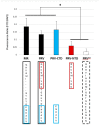A Novel Mechanism for Zika Virus Host-Cell Binding
- PMID: 31795144
- PMCID: PMC6949893
- DOI: 10.3390/v11121101
A Novel Mechanism for Zika Virus Host-Cell Binding
Abstract
Zika virus (ZIKV) recently emerged in the Western Hemisphere with previously unrecognized or unreported clinical presentations. Here, we identify two putative binding mechanisms of ancestral and emergent ZIKV strains featuring the envelope (E) protein residue asparagine 154 (ASN154) and viral phosphatidylserine (PS). Synthetic peptides representing the region containing ASN154 from strains PRVABC59 (Puerto Rico 2015) and MR_766 (Uganda 1947) were exposed to neuronal cells and fibroblasts to model ZIKV E protein/cell interactions and bound MDCK or Vero cells and primary neurons significantly. Peptides significantly inhibited Vero cell infectivity by ZIKV strains MR_766 and PRVABC59, indicating that this region represents a putative binding mechanism of ancestral African ZIKV strains and emergent Western Hemisphere strains. Pretreatment of ZIKV strains MR_766 and PRVABC59 with the PS-binding protein annexin V significantly inhibited replication of PRVABC59 but not MR_766, suggesting that Western hemisphere strains may additionally be capable of utilizing PS-mediated entry to infect host cells. These data indicate that the region surrounding E protein ASN154 is capable of binding fibroblasts and primary neuronal cells and that PS-mediated entry may be a secondary mechanism for infectivity utilized by Western Hemisphere strains.
Keywords: ASN154; Encephalitis; Flavivirus; Microcephaly; N-acetylglucosamine; Neurotropism; Zika Virus; binding motif.
Conflict of interest statement
The authors declare no conflicts of interest.
Figures





Similar articles
-
The Envelope Residues E152/156/158 of Zika Virus Influence the Early Stages of Virus Infection in Human Cells.Cells. 2019 Nov 15;8(11):1444. doi: 10.3390/cells8111444. Cells. 2019. PMID: 31731738 Free PMC article.
-
Envelope Protein Glycosylation Mediates Zika Virus Pathogenesis.J Virol. 2019 May 29;93(12):e00113-19. doi: 10.1128/JVI.00113-19. Print 2019 Jun 15. J Virol. 2019. PMID: 30944176 Free PMC article.
-
A single mutation in the PrM gene of Zika virus determines AXL dependency for infection of human neural cells.J Virol. 2025 Apr 15;99(4):e0187324. doi: 10.1128/jvi.01873-24. Epub 2025 Mar 10. J Virol. 2025. PMID: 40062839 Free PMC article.
-
Structures of Zika Virus E & NS1: Relations with Virus Infection and Host Immune Responses.Adv Exp Med Biol. 2018;1062:77-87. doi: 10.1007/978-981-10-8727-1_6. Adv Exp Med Biol. 2018. PMID: 29845526 Review.
-
ZIKA virus entry mechanisms in human cells.Infect Genet Evol. 2019 Apr;69:22-29. doi: 10.1016/j.meegid.2019.01.018. Epub 2019 Jan 15. Infect Genet Evol. 2019. PMID: 30658214 Review.
Cited by
-
TGF-β1 Promotes Zika Virus Infection in Immortalized Human First-Trimester Trophoblasts via the Smad Pathway.Cells. 2022 Sep 27;11(19):3026. doi: 10.3390/cells11193026. Cells. 2022. PMID: 36230987 Free PMC article.
-
The Disorderly Nature of Caliciviruses.Viruses. 2024 Aug 19;16(8):1324. doi: 10.3390/v16081324. Viruses. 2024. PMID: 39205298 Free PMC article. Review.
-
Identification and characterization of key residues in Zika virus envelope protein for virus assembly and entry.Emerg Microbes Infect. 2022 Dec;11(1):1604-1620. doi: 10.1080/22221751.2022.2082888. Emerg Microbes Infect. 2022. PMID: 35612559 Free PMC article.
References
-
- Cauchemez S., Besnard M., Bompard P., Dub T., Guillemette-Artur P., Eyrolle-Guignot D., Salje H., Van Kerkhove M.D., Abadie V., Garel C., et al. Association between Zika virus and microcephaly in French Polynesia, 2013–2015: A retrospective study. Lancet. 2016;387:2125–2132. doi: 10.1016/S0140-6736(16)00651-6. - DOI - PMC - PubMed
-
- Brasil P., Calvet G.A., Siqueira A.M., Wakimoto M., de Sequeira P.C., Nobre A., Quintana M.e.S., Mendonça M.C., Lupi O., de Souza R.V., et al. Zika Virus Outbreak in Rio de Janeiro, Brazil: Clinical Characterization, Epidemiological and Virological Aspects. PLoS Negl. Trop. Dis. 2016;10:e0004636. doi: 10.1371/journal.pntd.0004636. - DOI - PMC - PubMed
Publication types
MeSH terms
Substances
Grants and funding
LinkOut - more resources
Full Text Sources
Medical

